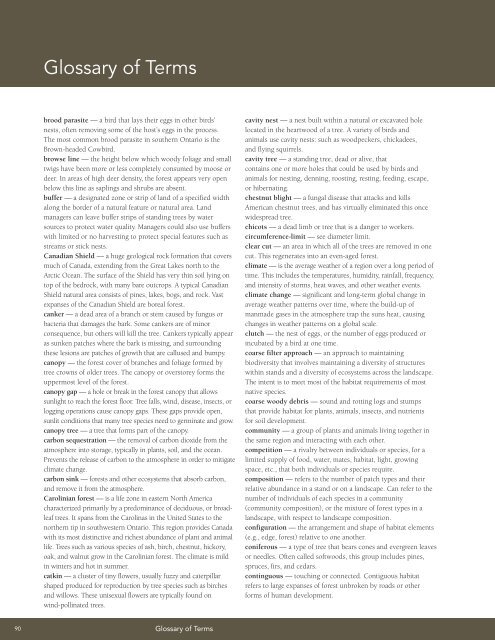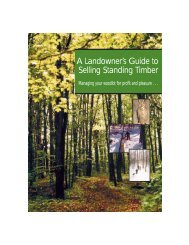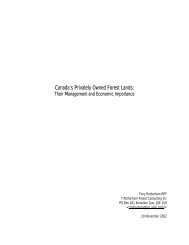A land manager's guide to conserving habitat for forest birds in ...
A land manager's guide to conserving habitat for forest birds in ...
A land manager's guide to conserving habitat for forest birds in ...
You also want an ePaper? Increase the reach of your titles
YUMPU automatically turns print PDFs into web optimized ePapers that Google loves.
Glossary of Terms<br />
brood parasite — a bird that lays their eggs <strong>in</strong> other <strong>birds</strong>’<br />
nests, often remov<strong>in</strong>g some of the host’s eggs <strong>in</strong> the process.<br />
The most common brood parasite <strong>in</strong> southern Ontario is the<br />
Brown-headed Cowbird.<br />
browse l<strong>in</strong>e — the height below which woody foliage and small<br />
twigs have been more or less completely consumed by moose or<br />
deer. In areas of high deer density, the <strong>for</strong>est appears very open<br />
below this l<strong>in</strong>e as sapl<strong>in</strong>gs and shrubs are absent.<br />
buffer — a designated zone or strip of <strong>land</strong> of a specified width<br />
along the border of a natural feature or natural area. Land<br />
managers can leave buffer strips of stand<strong>in</strong>g trees by water<br />
sources <strong>to</strong> protect water quality. Managers could also use buffers<br />
with limited or no harvest<strong>in</strong>g <strong>to</strong> protect special features such as<br />
streams or stick nests.<br />
Canadian Shield — a huge geological rock <strong>for</strong>mation that covers<br />
much of Canada, extend<strong>in</strong>g from the Great Lakes north <strong>to</strong> the<br />
Arctic Ocean. The surface of the Shield has very th<strong>in</strong> soil ly<strong>in</strong>g on<br />
<strong>to</strong>p of the bedrock, with many bare outcrops. A typical Canadian<br />
Shield natural area consists of p<strong>in</strong>es, lakes, bogs, and rock. Vast<br />
expanses of the Canadian Shield are boreal <strong>for</strong>est.<br />
canker — a dead area of a branch or stem caused by fungus or<br />
bacteria that damages the bark. Some cankers are of m<strong>in</strong>or<br />
consequence, but others will kill the tree. Cankers typically appear<br />
as sunken patches where the bark is miss<strong>in</strong>g, and surround<strong>in</strong>g<br />
these lesions are patches of growth that are callused and bumpy.<br />
canopy — the <strong>for</strong>est cover of branches and foliage <strong>for</strong>med by<br />
tree crowns of older trees. The canopy or overs<strong>to</strong>rey <strong>for</strong>ms the<br />
uppermost level of the <strong>for</strong>est.<br />
canopy gap — a hole or break <strong>in</strong> the <strong>for</strong>est canopy that allows<br />
sunlight <strong>to</strong> reach the <strong>for</strong>est floor. Tree falls, w<strong>in</strong>d, disease, <strong>in</strong>sects, or<br />
logg<strong>in</strong>g operations cause canopy gaps. These gaps provide open,<br />
sunlit conditions that many tree species need <strong>to</strong> germ<strong>in</strong>ate and grow.<br />
canopy tree — a tree that <strong>for</strong>ms part of the canopy.<br />
carbon sequestration — the removal of carbon dioxide from the<br />
atmosphere <strong>in</strong><strong>to</strong> s<strong>to</strong>rage, typically <strong>in</strong> plants, soil, and the ocean.<br />
Prevents the release of carbon <strong>to</strong> the atmosphere <strong>in</strong> order <strong>to</strong> mitigate<br />
climate change.<br />
carbon s<strong>in</strong>k — <strong>for</strong>ests and other ecosystems that absorb carbon,<br />
and remove it from the atmosphere.<br />
Carol<strong>in</strong>ian <strong>for</strong>est — is a life zone <strong>in</strong> eastern North America<br />
characterized primarily by a predom<strong>in</strong>ance of deciduous, or broadleaf<br />
trees. It spans from the Carol<strong>in</strong>as <strong>in</strong> the United States <strong>to</strong> the<br />
northern tip <strong>in</strong> southwestern Ontario. This region provides Canada<br />
with its most dist<strong>in</strong>ctive and richest abundance of plant and animal<br />
life. Trees such as various species of ash, birch, chestnut, hickory,<br />
oak, and walnut grow <strong>in</strong> the Carol<strong>in</strong>ian <strong>for</strong>est. The climate is mild<br />
<strong>in</strong> w<strong>in</strong>ters and hot <strong>in</strong> summer.<br />
catk<strong>in</strong> — a cluster of t<strong>in</strong>y flowers, usually fuzzy and caterpillar<br />
shaped produced <strong>for</strong> reproduction by tree species such as birches<br />
and willows. These unisexual flowers are typically found on<br />
w<strong>in</strong>d-poll<strong>in</strong>ated trees.<br />
cavity nest — a nest built with<strong>in</strong> a natural or excavated hole<br />
located <strong>in</strong> the heartwood of a tree. A variety of <strong>birds</strong> and<br />
animals use cavity nests: such as woodpeckers, chickadees,<br />
and fly<strong>in</strong>g squirrels.<br />
cavity tree — a stand<strong>in</strong>g tree, dead or alive, that<br />
conta<strong>in</strong>s one or more holes that could be used by <strong>birds</strong> and<br />
animals <strong>for</strong> nest<strong>in</strong>g, denn<strong>in</strong>g, roost<strong>in</strong>g, rest<strong>in</strong>g, feed<strong>in</strong>g, escape,<br />
or hibernat<strong>in</strong>g.<br />
chestnut blight — a fungal disease that attacks and kills<br />
American chestnut trees, and has virtually elim<strong>in</strong>ated this once<br />
widespread tree.<br />
chicots — a dead limb or tree that is a danger <strong>to</strong> workers.<br />
circumference-limit — see diameter limit.<br />
clear cut — an area <strong>in</strong> which all of the trees are removed <strong>in</strong> one<br />
cut. This regenerates <strong>in</strong><strong>to</strong> an even-aged <strong>for</strong>est.<br />
climate — is the average weather of a region over a long period of<br />
time. This <strong>in</strong>cludes the temperatures, humidity, ra<strong>in</strong>fall, frequency,<br />
and <strong>in</strong>tensity of s<strong>to</strong>rms, heat waves, and other weather events.<br />
climate change — significant and long-term global change <strong>in</strong><br />
average weather patterns over time, where the build-up of<br />
manmade gases <strong>in</strong> the atmosphere trap the suns heat, caus<strong>in</strong>g<br />
changes <strong>in</strong> weather patterns on a global scale.<br />
clutch — the nest of eggs, or the number of eggs produced or<br />
<strong>in</strong>cubated by a bird at one time.<br />
coarse filter approach — an approach <strong>to</strong> ma<strong>in</strong>ta<strong>in</strong><strong>in</strong>g<br />
biodiversity that <strong>in</strong>volves ma<strong>in</strong>ta<strong>in</strong><strong>in</strong>g a diversity of structures<br />
with<strong>in</strong> stands and a diversity of ecosystems across the <strong>land</strong>scape.<br />
The <strong>in</strong>tent is <strong>to</strong> meet most of the <strong>habitat</strong> requirements of most<br />
native species.<br />
coarse woody debris — sound and rott<strong>in</strong>g logs and stumps<br />
that provide <strong>habitat</strong> <strong>for</strong> plants, animals, <strong>in</strong>sects, and nutrients<br />
<strong>for</strong> soil development.<br />
community — a group of plants and animals liv<strong>in</strong>g <strong>to</strong>gether <strong>in</strong><br />
the same region and <strong>in</strong>teract<strong>in</strong>g with each other.<br />
competition — a rivalry between <strong>in</strong>dividuals or species, <strong>for</strong> a<br />
limited supply of food, water, mates, <strong>habitat</strong>, light, grow<strong>in</strong>g<br />
space, etc., that both <strong>in</strong>dividuals or species require.<br />
composition — refers <strong>to</strong> the number of patch types and their<br />
relative abundance <strong>in</strong> a stand or on a <strong>land</strong>scape. Can refer <strong>to</strong> the<br />
number of <strong>in</strong>dividuals of each species <strong>in</strong> a community<br />
(community composition), or the mixture of <strong>for</strong>est types <strong>in</strong> a<br />
<strong>land</strong>scape, with respect <strong>to</strong> <strong>land</strong>scape composition.<br />
configuration — the arrangement and shape of <strong>habitat</strong> elements<br />
(e.g., edge, <strong>for</strong>est) relative <strong>to</strong> one another.<br />
coniferous — a type of tree that bears cones and evergreen leaves<br />
or needles. Often called softwoods, this group <strong>in</strong>cludes p<strong>in</strong>es,<br />
spruces, firs, and cedars.<br />
cont<strong>in</strong>guous — <strong>to</strong>uch<strong>in</strong>g or connected. Contiguous <strong>habitat</strong><br />
refers <strong>to</strong> large expanses of <strong>for</strong>est unbroken by roads or other<br />
<strong>for</strong>ms of human development.<br />
90<br />
Glossary of Terms

















